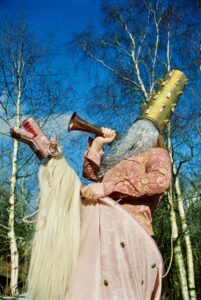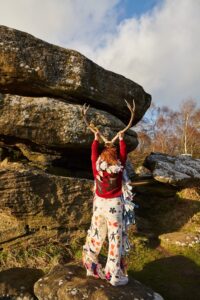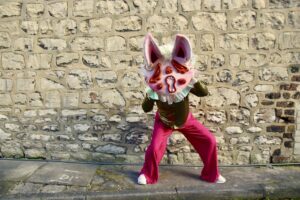With her ‘Oss Girls exhibition at Field System, Devon, just over the horizon, Kirsteen McNish interviews artist Lucy Wright about gentle resistance, accessibility to the folk arts, and solo morris dancing in Holiday Inn carparks. Photos: Leonie Freeman (top-middle) and Tilo Riefenstein (bottom).

Lucy Wright strikes me as a vital, questioning, vibrant force of nature. Her background is steeped in deep learning and is intricately woven around the understanding of folk customs both old and new, which she uses to flip the coin on well-harrowed expectations. She is interested in both celebrating and subverting traditions, whilst creating new rituals and customs that include those who often cannot connect with others easily. She is radical, questioning and fundamentally wants people, especially women, to reclaim their spaces, bodies and creative practices without the projections and unwanted interventions of others. One of the many reasons I was drawn to Lucy’s work was her evident sense of exultation in all she does, elevating both the traditional and more surreal, and how her brilliant imagination truly runs wild in her aesthetic, helping challenge societal constructs and bring in the new in myriad ways. Her Folk Is A Feminist Issue Manifesta challenges the concepts of capitalism, how we occupy spaces, and raising visibility in an age of evidencing what we do online. The very nature of the manifesta challenges the idea that creative work, stories, rituals, have to be evidenced publicly — on the internet or within an accepted canon — to be validated, or indeed valued; instead proposing that they can exist in the moment — which to me, in an age of social media, institutional narrowness, cliques and tribalism, sings a clear and important song. The fact you are doing it, says Lucy, is in and of itself enough — folk is in fact for everyone, and Wright’s manifesta will not uphold narrow, reductive ways of seeing. She also rejects the idea that you need to “gather” — one the most refreshing approaches sewn into the seams of her valuable work.
Launching at the exciting new arts space Field System in Ashburton, Devon, on May 1st, ‘Oss Girls flings open the door to summer and examines the folk archetype of the hobby horse, in particular drawing inspiration from the well-known ’Obby ’Oss tradition which takes place each May in Padstow, North Cornwall. Field System feels like a special space that celebrates its surroundings cheek by jowl with the wild moors and river that courses under your feet as you walk this stannery town, exhibiting artists that are situated both locally and from further afield and embracing the peculiar, unusual and the ritual.
Wright explains that whilst the traditional hobby horse is generally viewed as a carnivalesque figure of fun — whose wild antics chasing around a town help to temporarily suspend the norms and hierarchies of everyday life — the practice of chasing and capturing female audience members (who are said to then become pregnant) gestures towards a peculiarly predatory heteronormativity.
She also interrogates the nicknames ‘hobby horse’ as one of several names used to disparage girls and young women with a keen interest in horses (AKA ‘horse girls’), who are often bullied for their social awkwardness and presumed erotic attachment to their equine companions. Asking what if ‘horse girls’ were celebrated, not mocked, and what if the hobby horse was femme, and the hobby horse tradition underpinned by an ethics of consent and inclusion, she also looks at how folk practices of all kinds could indeed help us to navigate changing attitudes towards gender and intimacy.
I asked Lucy a bit more about her work, her forthcoming exhibition and talks/performances, all taking place in Ashburton next month.

What are the most enjoyable and enlightening things about dancing alone, and what led you to this solo practice?
This is a great question! So, morris dancing— morris dancing in a team — has always been a part of my cultural upbringing. My Dad was a morris man back in the 1970s (before I was born!) and I danced Waters Green Morris in Cheshire when I was a student. Being part of the team was not only a total joy, but it also gave me a sense of belonging when I needed it most, living alone for the first time and feeling far from home.
However, when my partner and I moved to West Yorkshire a few years ago for work, I had to leave my morris friends behind. Swiftly followed by a global pandemic, and coupled with a paucity of teams performing my preferred style and allowing women to join meant that I didn’t dance at all for a while.
But last year, I was travelling for work over May Day — an increasingly important date in the morris dancing calendar, when lots of teams dance at dawn to mark the start of summer — and I decided I was going to do it anyway. I unearthed an old morris jacket and my Dad’s old bells, and I danced the sun up — alone — in the pay and display carpark at the back of my Holiday Inn.
Apart from giving a few early morning commuters and street cleaners the fright of their lives, I had a blast dancing solo. It was exhilarating, and it also helped me feel connected to a tradition much older than I am, and all the other people doing similar things elsewhere in the world. I decided to call this type of dancing ‘hedge morris’, in tribute to a book I’d loved as a teenager, Hedge Witch by Rae Beth, about solitary witchcraft. That word ‘hedge’ has a long history of usage in relation to unofficial and unaffiliated practices, like hedge schools and hedge churches, which felt appropriate. And I was so excited about its potential to speak for a sort of creative reclamation of morris as something you could do your own way, and make your own.
When I shared my thoughts on social media, quite a few people seemed to find the concept empowering too, and I’ve spent the last few months creating resources and inspo for those who would like to give morris dancing a go, but maybe feel excluded on grounds of race, gender, disability, sexuality etc. I joke that we’ve grown into a small army of misfit morris dancers, all dancing in our own gloriously non-canonical ways, marking the passing of the seasons and celebrating the blessing it is to be alive, right now, in this moment. It’s been fantastic to watch it unfold.
To me ‘Oss Girls addresses ableism as well as engendering a re-examination of folklore practices. What would you see change if you could about traditional folk practices, or are you more focussed on adding layers and creating more dialogue?
Shamefully it was something I’d previously never given a lot of thought to — how inaccessible so many folk traditions and practices might be for people with chronic illnesses and disability. When I first started sharing my solo outings as a hedge morris dancer, quite a few disabled people got in touch to say they’d always wanted to morris dance but were unable to join a side, or had limitations which impacted the types of choreography they could perform. I love that hedge morris dancing offers an alternative — both in terms of how it’s performed and where. Last year at Dusking (my totally invented tradition to mark the onset of winter, held on 31 October) we had hedge morris dancers who performed while seated, or even lying down, and it was so wonderful to be part of a tradition that welcomed everyone, that did not require expensive travel or equipment, and embraced so much diversity and creativity of interpretation. For me that’s what folk is really about.
In answer to your question, though, I’d say that as an artist with a background in academic folklore, I like to try to balance both effecting change AND developing dialogue. Hopefully they sometimes go hand in hand! I must admit, I’m always a bit concerned that people might interpret my work as hyper-critical of existing folk practices and events, which is absolutely not my intention. I love the folk arts with my whole heart! But at the same time, I feel it’s important to offer new perspectives too. Many of the customs practiced today have their roots in the first folk revival of the late 19th and early 20th centuries, which weren’t exactly a golden era for gender equity, or any other kind of equity, and if we insist on preserving them without any changes, we risk perpetuating the same kinds of exclusion and prejudice that were commonplace at that time. Perhaps by creating and celebrating more inclusive traditions for the 21st century, we can ensure that the heritage that we pass on to the next generations is more representative of where we are as a society, and the values we believe in. I really believe that folk should be for everyone.
In terms of place – is there somewhere you personally love to hedge dance – wild expanses of the moors or something far more domestic, like a garden, park or living room?
I’ve always felt that there’s something visually interesting and maybe even kind of radical to perform these dances that are widely perceived as ancient and rural in spaces that are decidedly modern and urbanised. But it also depends a bit on what I’m wearing! For me the magic is in the tension, so if my hedge morris costume is more on the rustic side, I love to see it in a space at odds with it, like a suburban bus stop or new-build estate, while if I’m going all out ‘cyber-morris’, it looks fun in an idyllic rural landscape.
Optics aside, my favourite place to dance at the moment is Brimham Rocks in North Yorkshire. A vast natural rockscape that for centuries was believed to have Druidic significance, it’s just so atmospheric. I was there a few weeks back with the photographer, Leonie Freeman, and it was magical!

As we get older we can unlearn how to revel and dance. Aside from the physical and the limitations of body, what do you feel is the most important element of ‘Oss Girls as a woman, in re-addressing our own long held perceptions of customs?
Ah this is another brilliant question! Dancing, like all the arts honestly, is one of those things that for many of us can seem frivolous or even mortifying post-childhood, unless we’re certified ‘professional’ at it. For me, ‘folk’ speaks directly to that, as the culture that we make for ourselves, that permits active engagement at all levels (not just consumption) and that does not demand perfection, even though many folk artists are highly skilled too. If hedge morris dancing can be a space for people to throw off their self-consciousness about not being ‘good enough’ to dance for the joy of it, then I feel like my work is done!
At the same time, women were prevented from morris dancing for many years, even though historically both men and women had always danced. Early folklorists speculated that morris was an ancient pagan practice, a remnant of a male priestly rite, and that women’s involvement destroyed the ritual, but this was totally debunked a long time ago. Where women and girls continued to dance, like in the industrial northwest, they were branded inauthentic and written out of the history books. Things have changed a lot in more recent times, but there’s still lots of work to do to uncover some of the hidden histories of women in morris, and to make the tradition more welcoming to newcomers, especially those with marginalised identities.
As for ‘Oss Girls, it’s been about taking a wry, hopefully playful look at the hobby horse tradition in the southwest, taking particular inspiration from one of our best-known seasonal folk customs, the ‘Obby ‘Oss festival in Padstow, Cornwall. It’s an incredible, riotous event, with the centrepiece being a chap dressed as the ‘oss (horse) who processes through the streets and tries to capture women from the audience under his skirts. The captured women are then said to become pregnant. That particular aspect has always struck me as being a tad heteronormative, gesturing to something kind of predatory. I absolutely don’t want to be the fun police, and I also don’t think for a second that anything negative is intended at the event, but at the same time, it probably wouldn’t be my first choice of premise if I were creating a folk custom from scratch in 2024. So I wanted to explore visually what it would be like if this folk archetype was femme and folk customs underpinned by an ethics of consent. Almost all of our folk archetypes are male, so it’s really just flipping that and seeing what happens.
We are seeing a resurgence in the UK I think in ritual and the celebration of customs, in the face of climate breakdown, community erosion and fiscal collapse. What do you think has led to this turning to folk — is it self-reliance and instinct perhaps?
I think you’re absolutely right. The established ways of living together on the planet have failed — we’re having to face up to the ways we’ve harmed our earth and each other, and what an unjust mess uncontrolled capitalism is — and lots of us are looking for alternatives. Folk is appealing because it appears to gesture towards something older, more pared back, to rootedness in places and coming together with others to notice, reflect, and honour the seasons of nature and our own lives, something our secular society doesn’t always provide many opportunities to do. But I think there’s also a danger in viewing folk as unproblematically benign — history shows us how readily an aesthetics of folk has been co-opted to speak for nationalist and colonialist agenda — for excluding and brutalising those whose folk doesn’t look like our own. For me, folk works best when it acts as a form of gentle resistance, a way of foregrounding marginalised voices and agitating for change in the world now, not just retreating into the comforting fiction of an imagined past.
How important is costume to you and the DIY creation of it?
Ahhhh costume is the MOST important to me! Or at least, it’s something I feel passionately about! I’m by no means a skilled seamster, although I wish I was! Both of my grandmothers were very accomplished, but it’s another practice that’s fallen away in more recent decades, as clothes are so (comparatively) cheap to buy, and thus so disposable. Folk costumes are sort of the exception to that because you can’t get them off the peg, you have to make them yourself. Everything I do has to be achievable in my little attic studio at home, with my very rudimentary skills, but that feels suitably folk too, and I often use reclaimed fabrics and bits and pieces I find in charity shops etc. Although lots of older folk costumes were often highly ornate, they also made use of whatever materials were readily available, and deployed fairly straightforward techniques, like sewing rags to a jacket, or adding flowers to a hat — something simple that adds impact. When we make our own costumes, most of us are engaging in something we don’t do all that often — so it’s quite liberating to customise something to our own exact specification, to imbue it with our own special kind of magic. My costumes are the ultimate in dopamine dressing for me!
*
I really hope as I watch the pink full moon rise over the hills of Dartmoor that Lucy gets her wish to collaborate with artist Charles Le Fevre, and that she soon merrily dances the Giants Causeway in Antrim, retracing the steps of her ancestors. Wright is an ascendant star who seems entirely and univocally herself, no matter where and with whom she practices.
*
Details of the ‘Oss Girls May Day Festival — a celebration of the opening of ‘Oss Girls at Field System — can be found here. ‘Oss Girls runs at Field System, 13 West Street, Ashburton, Devon TQ13 7DT from Wed 1 May – Sat 18 May 2024.
Visit Lucy Wright’s website here / find out more about Field System here.